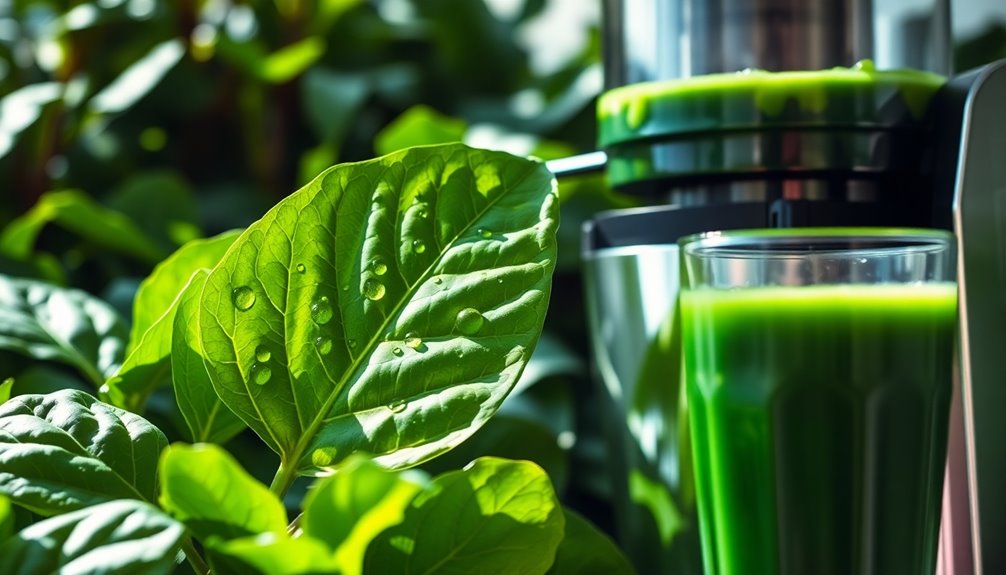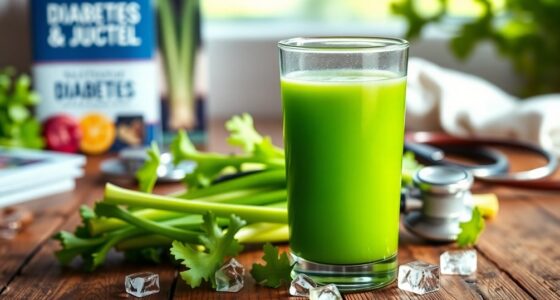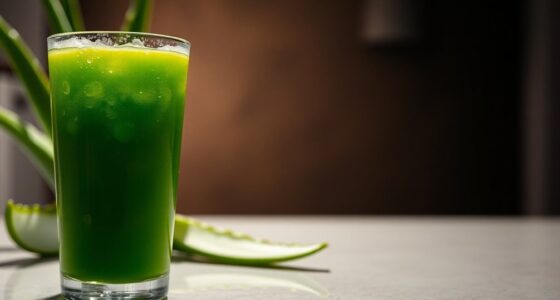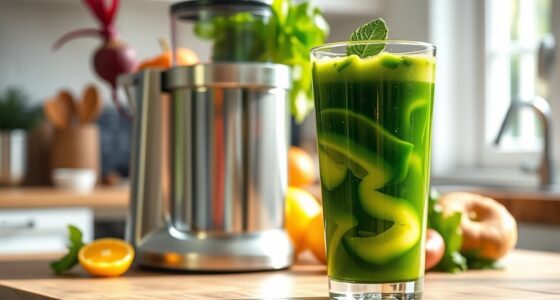To juice spinach for maximum nutrient power, start with a cup of fresh spinach, two kale leaves, dandelion greens, parsley, and celery. Add a Golden Delicious apple for sweetness and half a lemon to enhance vitamin C absorption. Use a cold press juicer to retain nutrients and minimize oxidation. Juice your greens first, followed by wetter ingredients. Enjoy it fresh over ice for the best taste, and there's more you'll discover about enhancing your juice even further.
Key Takeaways
- Use fresh, organic spinach and complementary greens like kale and dandelion for enhanced nutrient profiles and flavors.
- Employ cold press juicing to maximize nutrient retention and minimize oxidation for cleaner juice.
- Include a Golden Delicious apple and half a lemon to naturally sweeten and boost vitamin C for better iron absorption.
- Juice leafy greens first, followed by wetter ingredients, and run the pulp through again to extract maximum juice.
- Enjoy the spinach juice fresh within 24 to 48 hours and experiment with various fruits for flavorful blends.
The Nutritional Benefits of Spinach
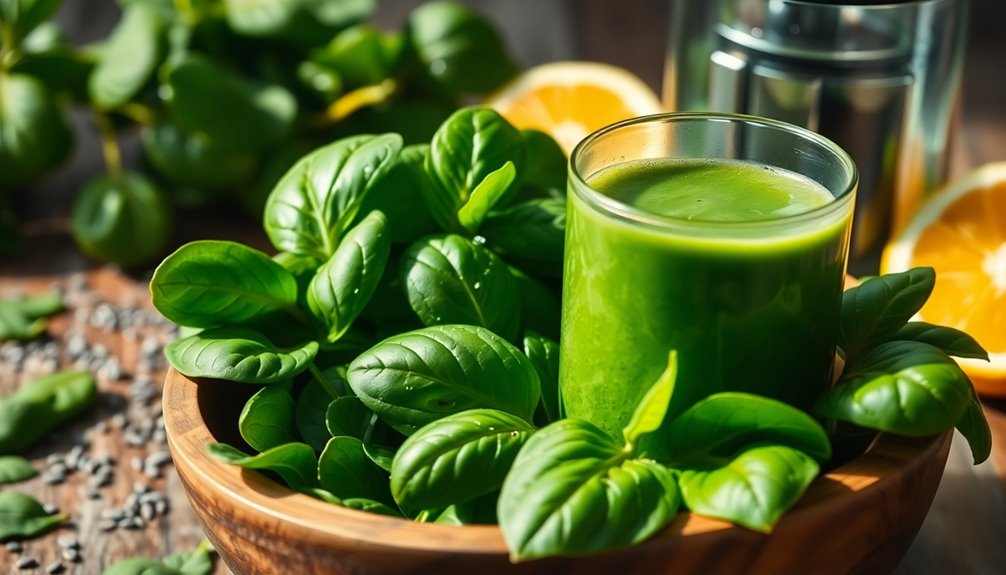
When it comes to leafy greens, spinach stands out for its impressive nutritional profile. Packed with essential vitamins and minerals, it offers a plethora of nutritional benefits that can enhance your health.
A single cup of raw spinach supplies an incredible 181% of your daily vitamin K needs, vital for bone health and blood clotting. Additionally, its antioxidants, like lutein and zeaxanthin, support eye health and may lower the risk of age-related issues.
With high fiber content, spinach can aid digestion and promote a healthy gut, while its low calorie count makes it an ideal choice for weight management. Plus, it's a decent source of plant-based protein, perfect for vegetarians and vegans looking to boost their intake.
Essential Ingredients for Your Spinach Juice
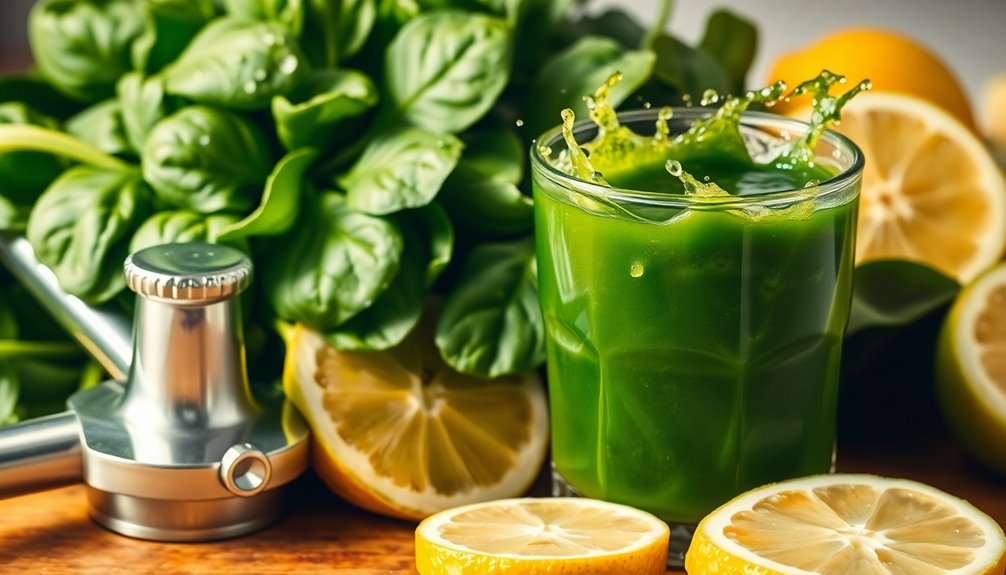
Juicing spinach can be a delicious way to harness its impressive nutrient profile. Start with one cup of spinach for its mild flavor and rich content of vitamins A, C, and K, along with iron and calcium.
To boost the health benefits, add two leaves of kale and a small bunch of dandelion greens. For extra vitamins and minerals, toss in a handful of Italian parsley, focusing on the stalks.
Two stalks of celery not only enhance texture but also provide hydration. Sweeten your juice naturally with a Golden Delicious apple, and squeeze in half a lemon for a revitalizing brightness.
This combination of fruits and vegetables will help support your immune system while providing a tasty, nutrient-packed drink!
The Importance of Cold Press Juicing
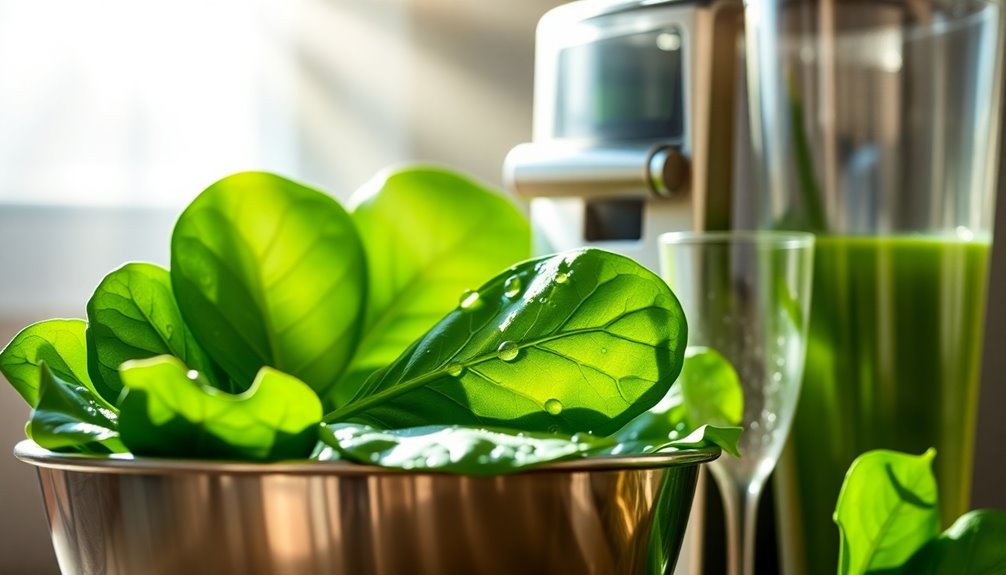
Cold press juicing is essential for anyone looking to maximize the health benefits of their fruits and vegetables. This method involves crushing and pressing produce to extract juice, ensuring you get a good amount of nutrients without the heat that can destroy vitamins.
Unlike conventional juicers, cold press juicing minimizes oxidation, resulting in a cleaner, nutrient-dense juice that stays fresh for 24 to 48 hours in your fridge.
Using whole, organic fruits and vegetables not only enhances flavor but also helps you lose weight by keeping your juices free from pesticides and additives. Incorporating these fresh ingredients into your daily routine ensures that you’re consuming a nutrient-rich diet that supports overall health. Additionally, when you lose weight with organic juices, you benefit from essential vitamins and minerals that are often lost in processed products. This natural approach not only promotes weight loss but also boosts your energy levels, leaving you feeling revitalized throughout the day. Moreover, drinking healthy organic weight loss juices can help curb cravings, making it easier to stick to your diet plan. These juices are packed with antioxidants that not only aid in detoxifying your body but also improve digestion and metabolism. By choosing to incorporate these wholesome beverages into your lifestyle, you’re making a powerful commitment to your health and wellness journey.
Plus, you won't need to chop or cut your ingredients, saving you prep time while encouraging daily intake of essential nutrients.
Step-by-Step Juicing Process

To get the most out of your juicing experience, you'll want to start with proper ingredient preparation. Understanding juicing techniques will help you maximize nutrient extraction and flavor. To ensure optimal freshness, consider using high-quality fruits during your juicing process. Finally, serving your juice over ice can make it even more enjoyable and invigorating.
Ingredients Preparation Tips
When preparing to juice spinach and other leafy greens, start by gathering your ingredients for a nutrient-rich blend.
To maximize nutrient extraction, juice all leafy greens first, like kale and dandelion greens. Using a cold press juicer is essential, as it preserves the vitamins and nutrients that your body needs without generating heat.
After juicing, run the pulp through the juicer again to extract any remaining juice, minimizing waste. Next, mix in wetter ingredients like apples and lemon to enhance flavor and sweetness.
This nutrient-packed juice helps reduce the risk of cancer and boosts overall health. Additionally, incorporating parsley juice benefits can further enhance the health properties of your juice.
Finally, serve your invigorating drink over ice, making it an enjoyable superfood treat!
Juicing Techniques Explained
Now that you've prepared your ingredients, it's time to explore the step-by-step process of juicing spinach and other leafy greens. Follow these techniques to maximize nutrient extraction every day:
| Step | Description |
|---|---|
| 1. Wash Ingredients | Rinse all leafy greens thoroughly to remove dirt. |
| 2. Use Cold Press | Utilize a cold press juicer for peak nutrient yield. |
| 3. Juice Order | Start with leafy greens, then add wetter ingredients. |
If you're using a conventional juicer, consider running the pulp through again to extract more juice and reduce waste. Finally, serve your fresh juice over ice for a revitalizing drink, which can retain its nutrient density for up to 48 hours in the fridge. Drinking green juices can help detoxify the body and eliminate toxins, enhancing your overall wellness.
Serving and Enjoying
After you've successfully juiced your spinach and other greens, serving and enjoying your nutrient-packed drink is the next step.
Start by juicing all your leafy greens—spinach, kale, and dandelion greens—to maximize nutrient extraction. Once you've got the juice, run the pulp through the juicer again to squeeze out every last drop.
Next, blend your green juice with wetter ingredients like apples and lemon to create a balanced flavor profile. Pour this vibrant mixture over ice to enhance its invigorating taste.
For the best health benefits and ideal freshness, enjoy your superfood juice immediately. Sipping it right away guarantees you get the full impact of those nutrients, making your effort truly worthwhile! Additionally, incorporating ingredients like folate-rich foods can further support overall health and nutrient absorption.
Sweetening Your Spinach Juice
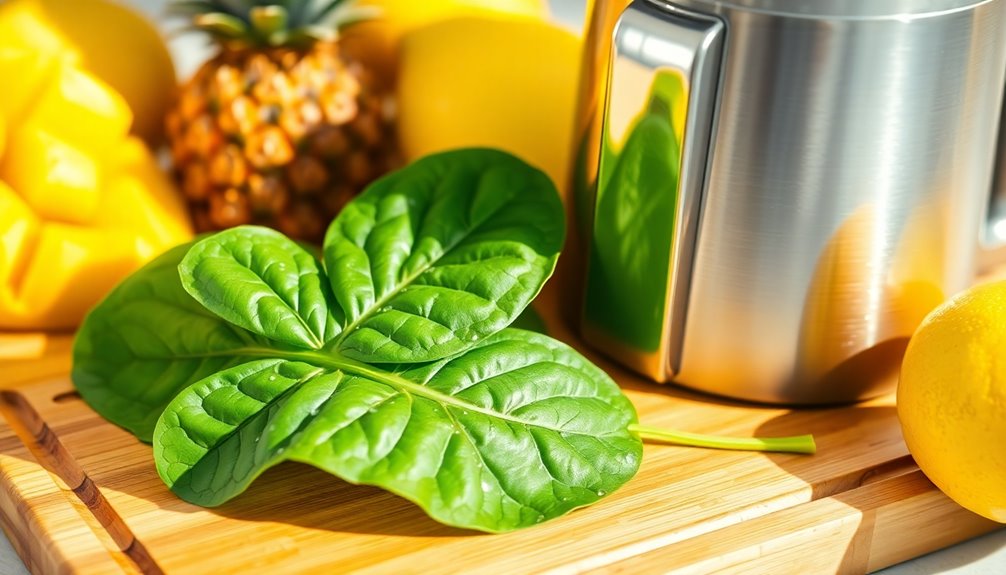
When sweetening your spinach juice, choosing the right ingredients is key.
You can balance the flavors by adding fruits like Golden Delicious apples or a splash of lemon for brightness.
Don't hesitate to adjust the sweetness level to match your taste—experimenting can lead to the perfect blend! Additionally, using freshly grated zest can enhance the overall flavor profile of your juice.
Choosing Sweet Ingredients
To make your spinach juice more enjoyable, consider sweetening it with fruits that complement the greens without overwhelming their flavor. Here are some great options to try:
- Golden Delicious Apple: Adds natural sweetness and balances the earthy taste of spinach.
- Half a Lemon: Enhances flavor and boosts vitamin C for better iron absorption.
- Additional Apples: Feel free to adjust the amount of apple to suit your sweetness preference.
- Ice: Blend in ice for a revitalizing drink, especially during hot weather.
- Other Fruits: Experiment with pears or ripe bananas for added sweetness and texture.
These ingredients help create a delicious and nutrient-dense juice that you'll look forward to drinking! Additionally, incorporating unique juice recipes can help you discover new flavor combinations that enhance your overall health.
Balancing Flavor Profiles
While spinach brings a wealth of nutrients to your juice, its earthy flavor can be a bit overwhelming without the right balance. To enhance your spinach juice, try adding a Golden Delicious Apple. Its natural sweetness complements the greens without overpowering them.
A squeeze of half a lemon not only brightens the drink but also ties the flavors together, making each sip more enjoyable. If you find the bitterness of spinach too strong, don't hesitate to toss in more apple to suit your taste.
For a revitalizing finish, consider adding ice, which can mellow the flavors and create a cool, thirst-quenching beverage. Additionally, antioxidants found in spinach can further boost the health benefits of your juice, making it a delicious and nutritious treat!
Adjusting Sweetness Levels
Adjusting the sweetness levels in your spinach juice can transform it from a nutritious yet earthy drink into a delightful treat.
Here are some tips to sweeten your juice just right:
- Add one Golden Delicious Apple for natural sweetness without overpowering the spinach.
- Incorporate half a lemon to brighten flavors and boost vitamin C.
- For a sweeter experience, toss in another Golden Delicious Apple.
- Blend in some ice for a rejuvenating, slightly diluted drink if desired.
- Adjust sweetness gradually to meet your personal taste and dietary needs.
Experimenting with these additions allows you to create a spinach juice that's not only healthy but also enjoyable to sip! Additionally, consider using exotic fruit blends to enhance the flavor profile of your juice.
Enhancing Flavor With Complementary Greens
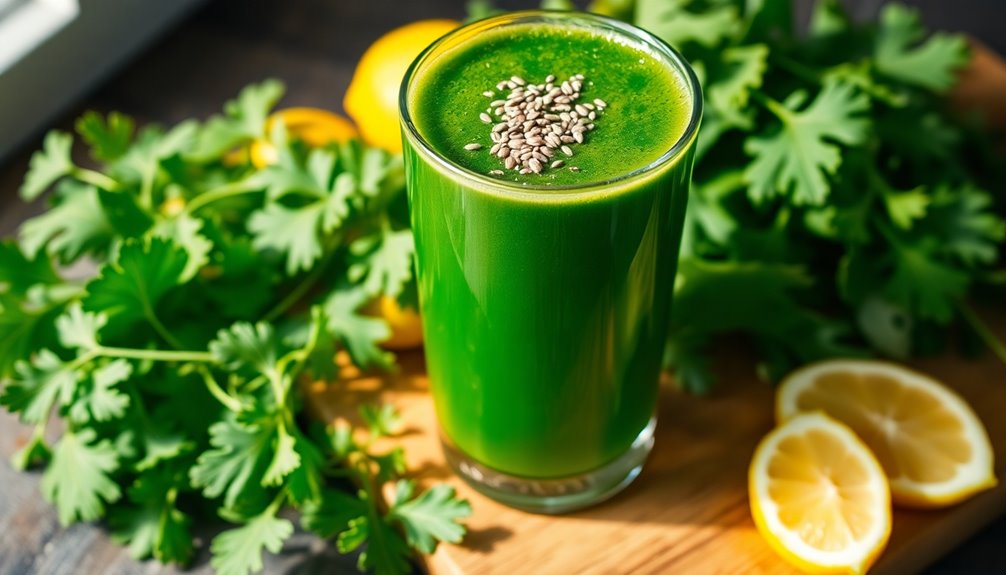
When you blend spinach with other complementary greens, you not only enhance the flavor but also elevate the nutritional profile of your juice. For instance, adding kale boosts vitamins A, C, and K, while dandelion greens purify your blood and liver. Italian parsley adds a concentrated flavor, perfectly balancing spinach's mildness. Including celery introduces a revitalizing crunch and hydration, thanks to its high water content. Finally, sweetening your juice with a Golden Delicious apple provides a delightful contrast to the earthy greens, making it more enjoyable. Incorporating these greens into your diet can lead to increased visibility and foot traffic for local health-focused events and gatherings.
| Green | Benefits |
|---|---|
| Kale | High in vitamins A, C, K |
| Dandelion Greens | Purifies blood and liver |
| Italian Parsley | Concentrated flavor |
| Celery | Revitalizing crunch and hydration |
| Golden Delicious Apple | Natural sweetness to balance flavors |
Serving and Enjoying Your Spinach Juice
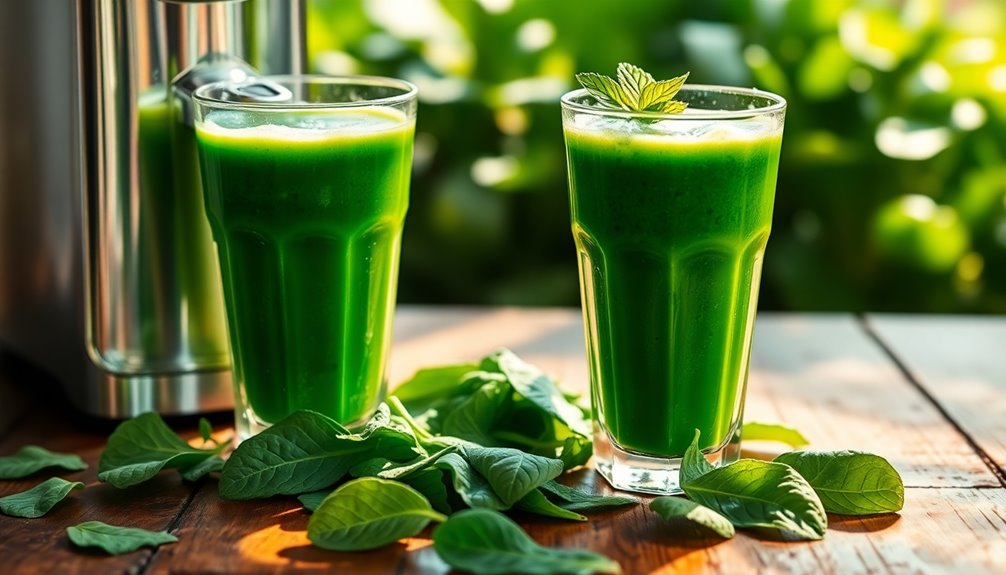
Serving your spinach juice over ice not only enhances its revitalizing qualities but also makes it a perfect treat on warm days.
To elevate your drinking experience, consider these tips:
- Combine spinach with kale or dandelion greens for a superfood boost.
- Add a Golden Delicious apple or lemon to balance the earthy flavor.
- Enjoy your juice fresh, ideally within 24 to 48 hours for the best taste and nutrients.
- Experiment with various fruits and veggies to discover your favorite blend.
- Serve in a stylish glass to make it feel even more special.
Get creative and find combinations that excite your palate while maximizing the nutrient power of your spinach juice!
Health Benefits of Leafy Greens
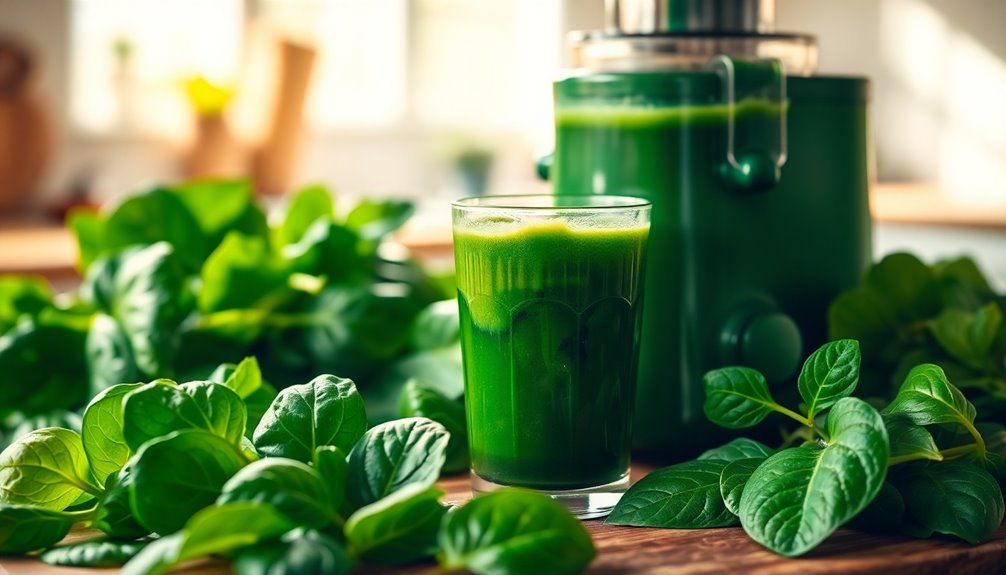
Leafy greens like spinach and kale pack a powerful nutritional punch that can greatly enhance your health.
They're loaded with essential vitamins and minerals, including vitamins A, C, K, and folate, all crucial for your overall well-being.
Consuming these greens aids in detoxification due to their high chlorophyll content, helping purify your blood and liver.
Regularly eating leafy greens supports your immune function, potentially lowering your risk of chronic diseases like cancer and heart disease.
Plus, they're low in calories and high in fiber, making them perfect for weight management and promoting healthy digestion.
For the best nutrient absorption, enjoy them raw or in juice form, ensuring you get the maximum benefits they offer. Additionally, incorporating essential oils for respiratory health can further enhance your overall wellness and support your body's functions.
Tips for Maximizing Juice Yield
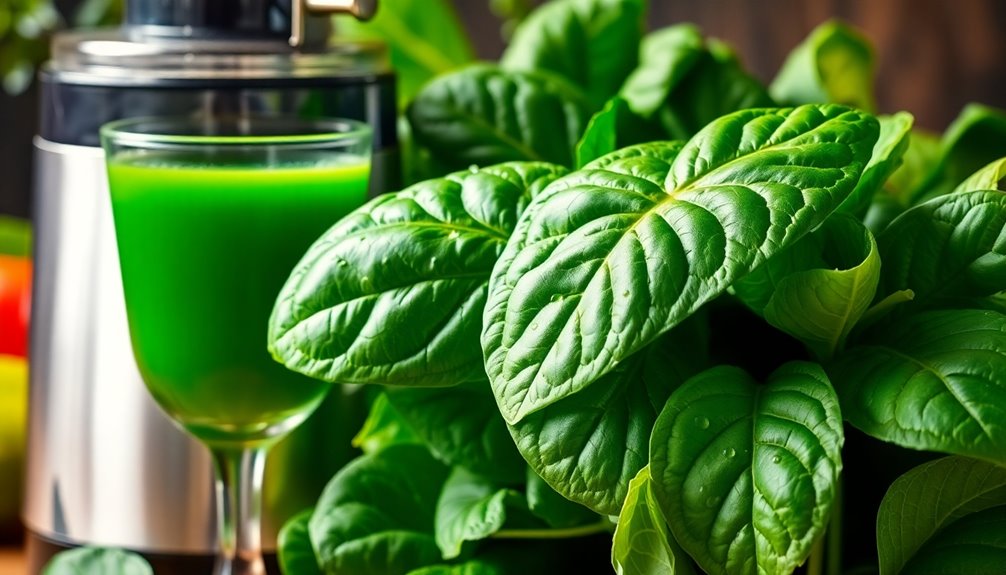
Maximizing juice yield is key to getting the most out of your spinach and other leafy greens. Here are some effective tips to help you boost your juice extraction:
- Juice leafy greens first to release moisture before adding denser fruits and veggies.
- Use a cold press juicer for better extraction and nutrient retention.
- Run the pulp through the juicer again to squeeze out any leftover juice.
- Add wetter ingredients like cucumbers or apples after juicing greens to enhance juice flow.
- Opt for organic spinach and other ingredients to guarantee maximum nutrient density.
Frequently Asked Questions
How Do You Get the Most Nutrients Out of Spinach?
To get the most nutrients out of spinach, use a cold press juicer to minimize heat and oxidation.
It's best to juice spinach first to maximize yield, and consider mixing it with other leafy greens for added vitamins and minerals.
Pairing spinach with a bit of citrus, like lemon, can enhance iron absorption.
Consume the juice immediately after preparing it to retain nutrients, as exposure to air can degrade vitamins over time.
Does Spinach Lose Nutrients When Juiced?
Juicing spinach might seem like a nutrient loss, but it's not all bad news.
While some water-soluble vitamins like vitamin C may degrade, you still get a concentrated source of essential nutrients like vitamin K, iron, and magnesium.
To keep those nutrients intact, try cold pressing instead of traditional juicing.
Consume your juice right away or store it in airtight containers to minimize exposure to light and air, ensuring you maximize its benefits.
Is It Good to Drink Spinach Juice Every Day?
Drinking spinach juice every day can be a great addition to your diet.
It's packed with essential vitamins and minerals like vitamin K and folate, which support your overall health.
Plus, the antioxidants in spinach juice help reduce oxidative stress and inflammation, lowering your risk of chronic diseases.
Just remember to balance it with a varied diet.
If you enjoy it, go ahead and sip on that green goodness daily!
Can You Put Spinach in a Juicer?
Absolutely, you can put spinach in a juicer! In fact, just one cup of spinach packs a whopping 181% of your daily vitamin K needs.
When you juice spinach, it's best to mix it with juicier fruits or veggies like apples or cucumbers to enhance flavor and texture.
Remember to wash your spinach well to get rid of any dirt or pesticides. Enjoy the nutrient boost in your juice!
Conclusion
Incorporating spinach juice into your diet is like giving your body a green hug. With its powerhouse of nutrients and vibrant flavor, you're not just sipping on a drink—you're fueling your health. By following the steps outlined, you can create a delicious and energizing elixir that boosts your well-being. So, grab your greens, embrace the juicing journey, and enjoy the myriad benefits that come with every invigorating sip. Cheers to your health!
Cindy thoroughly researches juicing trends, techniques, and recipes to provide readers with practical advice and inspiration. Her writing style is accessible, engaging, and designed to make complex concepts easy to understand. Cindy’s dedication to promoting the advantages of juicing shines through her work, empowering readers to make positive changes in their lives through the simple act of juicing.

